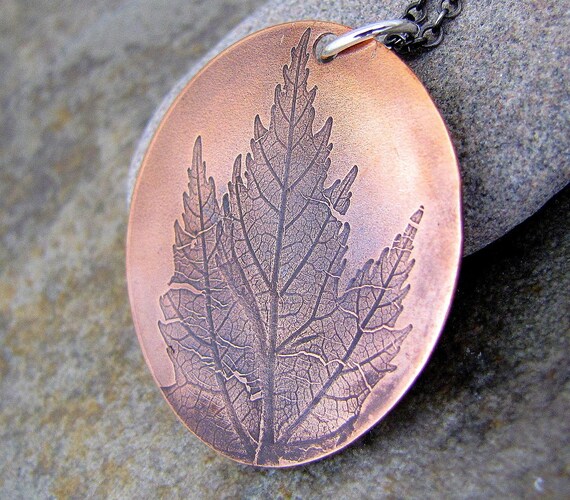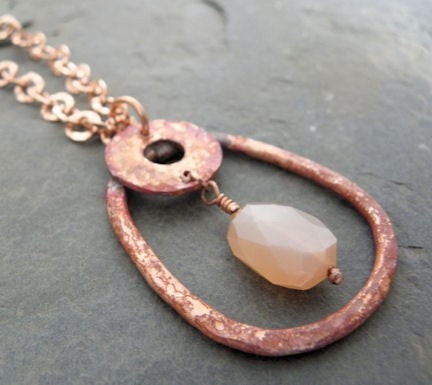 |
| Copper Maple Leaf Rustic Pendant Necklace by Silversmack |
I’m doing a series of blogs this week delving into the facts and myths about Gold, Silver, Copper, Nickel, and “other” metals. So far, I’ve discussed gold, silver and “silvery” metals. Next up is Copper.
Copper is a metallic element that occurs naturally in the environment, and also in plant and animal life. In fact, low levels of copper are essential for good health. It is rather soft and malleable and when fresh, has a pinkish or peachy color. Processing and heating copper results in a wide variety of color tones from yellowish red to deep coppery brown. Copper’s history in the making of tools dates back at least 10,000 years. It also is resistant to the growth of bacteria, making it useful in buildings such as hospitals. It is believed that it was first used in jewelry making as long ago as 6900 BC. Many ancient cultures, such as the ancient Egyptians, Pre Columbian Americans, and Sumerians used it commonly in their jewelry and bead making.
The first myth I want to dispel about copper is that if wearing it turns your skin green, you must be allergic to copper. NOT TRUE!! Any metal besides pure gold, pure silver, platinum, rhodium or titanium can turn your skin green. This means sterling silver and lower karat values of gold have been known to turn skin green due to the fact that they are alloys. It’s not the silver or gold that is creating the stain, it’s the metal it’s been alloyed with! And green or darkened skin is not an allergic reaction – it is simply that the metal that is coming in contact with your skin is oxidizing (basically tarnishing – which, remember, all metal but pure gold can do!) and the oxidation is transferring to your skin. High humidity, a tendency to sweat, or a slightly more acidic ph level in some people’s body chemistry can all contribute to staining. Wearing jewelry while using household chemicals can cause this type of reaction as well. Contact dermatitis is the most common indication that you may be allergic to a metal, but this will cause redness, itching, rashes, burning, and possibly even blistering. On the other hand, a build up of soap and water under a ring will leave the skin more sensitive to the nickel in most jewelry metals and create the same effect.
The bottom line is, most people are not allergic to copper. If your concern is that you want to avoid your skin turning green, there are a few things you can do!
Some ways to avoid the staining that occurs with wearing metal jewelry are:
1) Anywhere that the jewelry metal would come in contact with the skin, apply 2 coats of high quality clear nail polish. I have a friend who has a severe nickel allergy as well as problems with skin discoloration and she swears by this. Since so many things (like zippers, snaps, buttons, eyeglass frames, bra fasteners, etc) contain nickel, she coats them all and never has a problem!
2) Pretreat your skin – use a light layer of hydrocortisone cream applied twice within 3-6 hours before you wear the offending metal. While it won’t last forever, you should be able to wear the jewelry for a few hours without any problems.
3) Take the jewelry to a jeweler and ask that it be coated with a non-reactive metal like rhodium or any one of the many coatings commonly used to clearcoat the surface of metal jewelry.
4) Try one of the many jewelry coatings available to the public. Some of the more popular ones are Nickel Solution, and Nickel Guard. I don’t have any personal experience with them, but from what I’ve read, they can be effective for most people.
 |
| Woodland Robin Birdnest Cuff from starsb117 |
Well, now that you’re more knowledgeable about what causes and how to solve the problem of the green skin, let’s talk about copper allergies. Pure copper, when not mixed with any nickel or nickel alloys is considered a hypoallergenic metal. True copper allergies are extremely rare, but again, just like some people are allergic to pure gold or pure silver, it is possible to be allergic to any substance.
Another myth/misconception that I would like to address is the reference to copper is a substandard metal. You might be surprised to learn what other metals fall in the substandard category. I personally hate the word substandard, and I’m glad to see the jewelry industry moving to terms such as “alternative” or “contemporary” when describing non-precious metals. Since pure gold, pure silver, and metals of the platinum family are the only industry recognized “precious” metals, and since the popular trend is to say that anything that is not precious is substandard, that would put sterling silver and colored gold alloys into the so called “substandard” category as well. While copper is not considered a precious metal based on its availability, relatively low cost and the fact that it oxidizes more rapidly than say, pure silver or gold, the demand for copper is increasing rapidly, driving the price of this no longer “cheap” metal up more than 500% since 2001. It is durable, easy to work with, has a beautiful luster (although it does take a bit of work to keep shiny copper shiny!) and once again, for most people, pure copper is completely hypoallergenic.
Copper Grades, Classifications, and Specifications
Considering there are around 370 commercial compositions for copper alloys and because copper has so many non-jewelry uses, there is an extensive system of designations. I will only touch on the ones that apply to copper as it is used in the jewelry industry.
One of the specifications of copper alloys is temper level. Temper level is determined by the amount of cold working that is done in production and the level of annealing. Since this is a process that most metals go thru for use in the jewelry industry, I will go more into detail on exactly what hot and cold working are and the different tempers of all metals and metal wires in a subsequent post.
Common tempers for copper alloys are Soft, Half-Hard, Hard spring, and Extra spring.
 |
| Peach Faceted Moonstone in Hammered Copper by GotStyle |
Pure Copper – have a copper content of 99.3% or higher
High Copper Alloys –Wrought high copper alloys have Copper contents of less than 99.3% but more than 96% but don’t fall into another copper alloys group. Cast high copper alloys have Copper contents in excess of 94%. Silver may be added to impart special properties.
Brasses and Bronzes are the other two main divisions, but I will be addressing those in a future blog.
There are a number of other copper alloy groups, but the ones sometimes found in jewelry components are:
Copper-Nickel Alloys – the principal alloyin element is nickel, with or without other mtal alloying elements
Copper-Nickel-Zinc Alloys – commonly known as “Nickel Silver” (see yesterdays’s blog for more information on this alloy)
Leaded Coppers – cast copper alloys with 20% or more lead added. This alloy is not suitable for jewelry due to its high lead content
Special Copper Alloys – any alloy with a chemical composition that does not fall into any of the previously mentioned groups.
While I really don’t want to go into patinas or the effects of oxidation on copper today, I will mention that much of the copper jewelry that is available today has been treated either chemically or through some electrochemical process to create some level of oxidization, giving it a rich, “antiqued” look. More about that, other patinas and verdigris (vər-də-ˌgrēs) later in this series.
xo,


1 comment:
Great post! Thanks for including my Maple leaf pendant.
Post a Comment